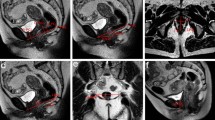Abstract
PURPOSE: Standard diagnostic proctologic procedures in the assessment of pelvic floor disorders include clinical evaluation and endoscopy. Particular aspects of combined pelvic floor disorders, especially those involving more than one pelvic compartment, may remain undetected without additional technical diagnostic procedures such as videoproctoscopy, cinedefecography, or colpocystodefecography. The aim of the study was to review the potentials of dynamic magnetic resonance imaging defecography to elucidate the underlying anatomic and pathophysiologic background of pelvic floor disorders in proctologic patients. PATIENTS AND METHODS: Dynamic magnetic resonance imaging defecography was performed in 20 Patients (13 females) with main diagnoses such as rectal prolapse or intussusception, rectocele, descending perineum, fecal incontinence, outlet obstruction, and dyskinetic puborectalis muscle after clinical evaluation. The investigation was performed on a 1.5 T-magnetic resonance imaging machine in supine position. The rectum was filled with Gd-DTPA enriched ultrasound gel. First a T1/T2 weighted investigation of the pelvis was performed, followed by defecography with evacuation of the rectum. Images were obtained in a sagittal plane in a frequency of 1 image/second (true FISP) at rest and during straining. The obtained magnetic resonance imaging video tapes were analyzed off-line with cinematographic evaluation of bladder base, uterus, and anal canal position in relation to the pubococcygeal line by a blinded radiologist. Investigation time was 20 minutes. RESULTS: In dynamic magnetic resonance imaging defecography of the pelvic floor, 12 patients with descending perineum, 10 rectoceles (10 females), 6 cystoceles (6 females), 4 enteroceles (4 females), 8 intussusceptions (5 females), and a dyskinetic puborectalis muscle in 3 males were detected. In 11 females and 3 males multifocal disorders were found, involving more than one compartment in females, whereas in males complex defects were restricted to the posterior compartment. Magnetic resonance imaging defecography revealed diagnoses consistent with clinical results in 77.3 percent and defects in addition to clinical diagnoses in combined pelvic floor disorders in 34 percent. CONCLUSIONS: In complex pelvic floor disorders, involving more than a single defect, dynamic magnetic resonance imaging represents a convenient diagnostic procedure in females and to a lesser extent in males, in particular in terms of dynamic imaging of pelvic floor organs during defecation. In addition to the clinical assessment, dynamic magnetic resonance imaging had clinical impact in proctologic and interdisciplinary treatment.
Similar content being viewed by others
References
Kelvin FM, Maglinte DD, Benson JT. Evacuation proctography (defecography): an aid to the investigation of pelvic floor disorders. Obstet Gynecol 1994;83:307–14.
Karasick S, Karasick D; Karasick SR. Functional disorders of the anus and rectum: findings on defecography. Am J Roentgenol 1993;160:777–82.
Benson JT, ed. Female pelvic floor disorders. Investigation and management. New York: WW Norton, 1992.
Brubaker L, Heit MH. Radiology of the pelvic floor. Clin Obstet Gynecol 1993;36:952–9.
Hock D, Lombard R, Jehaes C,et al. Colpocystodefecography. Dis Colon Rectum 1993;36:1015–21.
Sentovich SM, Rivela LJ, Thorson AG,et al. Simultaneous dynamic proctography and peritoneography for pelvic floor disorders. Dis Colon Rectum 1995;38:912–5.
Yang A, Mostwin JL, Rosenshein NB, Zerhouni EA. Pelvic floor descent in women: dynamic evaluation with fast MR imaging and cinematic display. Radiology 1991;179:25–33.
Kruyt RH, Delemarre JB, Doornbos J, Vogel HJ. Normal anorectum: dynamic MR imaging anatomy. Radiology 1991;179:159–63.
Healy JC, Halligan S, Reznek RH,et al. Dynamic MR imaging compared with evacuation proctography when evaluating anorectal configuration and pelvic floor movement. Am J Roentgenol 1997;169:775–9.
Lienemann A, Anthuber C, Baron A,et al. Dynamic MR colpocystorectography assessing pelvic-floor descent. Eur Radiol 1997;7:1309–17.
Schoenenberger AW, Debatin JF, Guldenschuh I,et al. Dynamic MR Defecography with a superconducting, open configuration MR system. Radiology 1998;206:641–6.
Delemarre JB, Kruyt RH, Doornbos J,et al. Anterior rectocele: assessment with radiographic defecography, dynamic magnetic resonance imaging and physical examination. Dis Colon Rectum 1994;37:249–59.
Siproudhis L, Ropert A, Vilotte J,et al. How accurate is clinical examination in diagnosing and quantifying pelvirectal disorders? A prospective study in a group of 50 patients complaining of defecatory difficulties. Dis Colon Rectum 1993;36:430–8.
Wiskind AK, Creighton SM, Stanton SL. The incidence of genital prolapse after the Burch colposuspension. Am J Obstet Gynecol 1992;167:399–404.
Yang XM, Partanen K, Farin P, Soimakallo S. Defecography. Acta Radiol 1995;36:460–8.
Ekberg O. Complications after herniography in adults. Am J Roentgenol 1983;140:491–5.
Bremmer S, Ahlbäck SO, Uden R, Mellgren A. Simultaneous defecography and peritoneography in defecation disorders. Dis Colon Rectum 38:969–73.
Kelvin FM, Maglinte DD, Hornback JA, Benson JT. Pelvic prolapse: assessment with evacuation proctography (defecography). Radiology 1992;184:547–51.
Wald A, Caruana BJ, Freimanis MG,et al. Contributions of evacuation proctography and anorectal manometry to evaluation of adults with constipation and defecatory difficulty. Dig Dis Sci 1990;35:481–7.
Goei R, Kemerink G. Radiation dose in defecography. Radiology 1990;176:137–9.
Jorge JM, Ger CC, Gonzalez L, Wexner SD. Patient position during cinedefecography: influence on perineal descent and other measurements. Dis Colon Rectum 1994;37:927–31.
Fielding JR, Versi E, Mulkern RV,et al. MR imaging of the female pelvic floor in the supine and upright position. J Magn Reson Imaging 1996;6:961–3.
Author information
Authors and Affiliations
About this article
Cite this article
Rentsch, M., Paetzel, C., Lenhart, M. et al. Dynamic magnetic resonance imaging defecography. Dis Colon Rectum 44, 999–1007 (2001). https://doi.org/10.1007/BF02235489
Issue Date:
DOI: https://doi.org/10.1007/BF02235489




